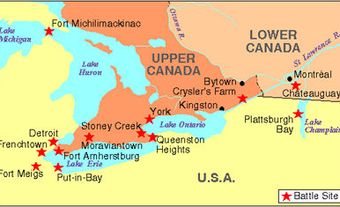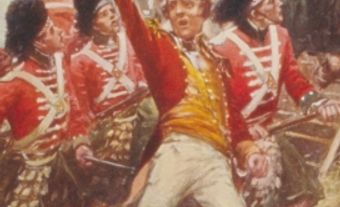Battle of Chippawa
The Battle of Chippawa, on 5 July 1814, was an American victory over British forces in the War of 1812. The principal American campaign for 1814 centred on sending Major-General Jacob Brown's Left Division of the US Army into the Niagara Peninsula, where it would meet the American Lake Ontario squadron and then raid Burlington Bay, York or Kingston as circumstances allowed.
Advance into Upper Canada
Brown's division crossed the Niagara River into Upper Canada on 3 July 1814 and within hours took possession of Fort Erie. Before surrendering, the fort's post commander dispatched riders to alert Major-General Phineas Riall, commander of the British Right Division, a geographic command stretching from York to the Niagara River, of the invasion.
At mid-day on 4 July, Brown sent a brigade under Brigadier-General Winfield Scott northward along the river road. After travelling a few miles, Scott encountered a force of infantry, cavalry and artillery under the command of Lieutenant-Colonel Thomas Pearson; Riall had instructed Pearson to maintain contact with the Americans and to delay their advance, giving Riall time to concentrate his troops. Pearson's effort paid off and it was dusk when Scott arrived south of the Chippawa River, which formed the British defensive line. Pearson crossed the river and the bridge was then partially destroyed by the British Engineers. Scott established a camp and awaited the arrival of the remainder of the division.
Between the two armies was a large plain that was bordered by woods on the west and the Niagara River on the east. Scott established a forward picket in some buildings near the middle of the field, while Riall ordered an Aboriginal party to observe and harass the Americans. During the 5th, Riall conducted a reconnaissance of Scott's encampment and wrongly concluded that he was faced by American militia. With 2000 British regulars, Canadian militia and First Nations warriors, Riall was convinced he could easily defeat the roughly 2000 Americans opposite him. Riall then commenced preparations to march onto the plain.
The Battle at Chippawa
Meanwhile, Brown had sent 500 Pennsylvania militia and warriors to clear the skirmishers from the wood-line. The Americans pressed the British northward until they collided with light infantry and Canadian militia under Pearson, who pushed the Americans southwards. As the struggle in the woods continued, Riall's men repaired the bridge over the Chippawa and moved onto the plain. Riall formed his brigade in line with the 1st Foot on the right, the 100th Foot on the left and the 8th Foot to the rear right. Three 6-pounder guns were on the right flank of the 1st Foot and two 24-pounder guns and one 5.5-inch howitzer were placed on the shore road.
In response, Brown ordered Scott's brigade onto the plain. Scott's men appeared just as Riall's men moved into position. As Riall watched the Americans maintain discipline under artillery fire, he suddenly realized that his opponent was not militia, but well-trained regulars. Scott placed the 25th Infantry on the left, the 11th Infantry in the centre and the combined 9th/22nd Infantry on the right. Two 6-pounder guns and a 5.5-inch howitzer were placed by the road. It was now about 4:30 p.m. and each side had approximately 2000 men on the field. Riall's plan was to advance in line, fire a volley and then charge, by which time he expected the American line to break.
As the 1st and 100th Foot advanced, the field became wider and the 8th Foot moved into line; this movement also masked the fire of the three 6-pounders. Scott, meanwhile, extended the interval between units, allowing the 25th Infantry to move into the wood-line, push Pearson back and then direct their fire onto the flank of the 8th Foot. The artillery duel continued and a British 12-pounder and the American howitzer were silenced.
American Victory
The battle now came down to the discipline and firepower of the two armies. For approximately 30 minutes, the soldiers on each side continually loaded their muskets, presented and fired. Casualties mounted. Brown ordered another regiment to move through the woods to outflank the British. He also brought up more artillery. A 12-pounder and a 6-pounder, along with a 5.5-inch howitzer, were quickly placed near the centre of the American line. The additional fire tipped the battle to the Americans' favour and the British began to waver. Riall ordered a withdrawal. The British left in good order, crossed the Chippawa River and then dropped the bridge. At about 6:30 p.m. the battle was over.
For the first time in the war, American regulars had defeated an equally sized British force in an open battle. British casualties included 148 dead, 321 wounded and 46 missing, while the Americans suffered 58 killed, 241 wounded and 19 missing. This was a momentous event; however, Brown's plan centred on a rapid advance to the northern end of the peninsula to rendezvous with the navy. With few reserves, it was imperative he maintain the strength of his division. For now, however, the Americans were pleased with the results.

 Share on Facebook
Share on Facebook Share on X
Share on X Share by Email
Share by Email Share on Google Classroom
Share on Google Classroom




